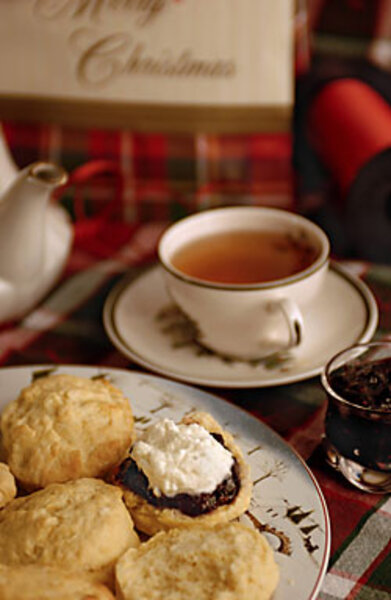Scones are as simple and quick as biscuits to make, but the key is in the technique to ensure a light texture instead of something you'd rather smother in gravy. In other words, heavy hands make a heavy scone. Use just your fingertips to rub the butter into the flour and to spread out the dough. Move quickly and make sure the oven is very hot for the best results.
The frothy cream for the top is also just as quick: Use a 1/2 pint of whipping cream and mix on high speed. Open a jar of your favorite fruit preserves, and you can adopt British tea time as easily as Lady Cora.
English scones
The key to making perfect scones is to use self-rising flour.Sifting the flour will add air and ensure that the scones are light. Work quickly and lightly and handle the dough as little as possible.
2 cups self-rising flour
2 tablespoons sugar
1/8 teaspoon salt
5 tablespoons butter, room temperature
1 egg
1/2 cup milk, approximately
1 cup whipping cream
Jam, to taste
Preheat oven to 450 degrees F. and grease a baking sheet.
Sift the flour into a mixing bowl. Add sugar and salt. Cut the butter into the bowl with a knife or pastry cutter. Using your fingertips, rub the butter into the flour until the mixture resembles fine bread crumbs. (You can also use a hand mixer to do this.) Make a well in the center of the mixture and drop in the egg. Adding a portion of the milk at a time, stir the egg and milk into the dough using a rounded-edge knife. How much milk you use depends on the size of the egg. The dough should incorporate all the flour, but it shouldn't be wet and sticky.
Turn the dough onto a floured surface. Using your fingertips, gently smooth out any cracks in the dough. Lightly press out the dough or roll lightly with a rolling pin until about 3/4 inch thick. Cut with a 2-inch round cutter dipped in flour. Place rounds on the greased baking sheet and brush the remaining milk on top with a pastry brush. Bake 10 to 12 minutes or until golden brown.
After removing the scones from the oven, put them onto a cooling rack covered with a tea towel. Place another tea towel on top of the scones to trap the steam and to keep the scones from drying out as they cool. Serve warm with jam and whipped cream (simply whip whipping cream on high with a mixer until soft peaks form). Makes 8 scones.
Fruit scones
Add 1/4 cup dried fruit, such as currents, raisins, or cranberries to the dry mixture.
Savory scones
Omit sugar. Add 1 teaspoon dry mustard and 3 to 4 ounces of grated cheese to the dry mixture.
Leftover scones can be frozen for several weeks. To reheat, wrap a frozen scone in a paper towel and microwave for 30 seconds. Enjoy!








